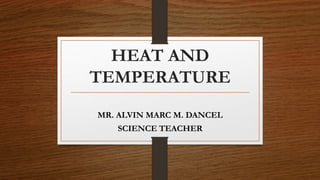
HEAT AND TEMPERATURE (WEEK SIX FOR GRADE 8- 1ST QUARTER).pptx
- 1. HEAT AND TEMPERATURE MR. ALVIN MARC M. DANCEL SCIENCE TEACHER
- 2. SCIENCE 8- WEEK 6 LEARNING COMPETENCY: The learner should be able to differentiate between heat and temperature at the molecular level.
- 8. HEAT ENERGY in transit. It is transferred from one body to another as the result of a difference in temperature. If two bodies at different temperatures are brought together, energy is transferred—i.e., heat flows—from the hotter body to the colder. The effect of this transfer of energy usually, but not always, is an increase in the temperature of the colder body and a decrease in the temperature of the hotter body.
- 9. HEAT Heat naturally moves from an object with high temperature to an object with low temperature. Objects do not contain heat; they contain thermal energy. However, scientists prefer the use of the term “internal energy” to refer to thermal energy. Object with greater mass have more thermal energy and can transfer more heat
- 10. TEMPERATURE is the amount of energy present in an object due to the motion of its particles or molecules. The greater the motion of the molecules of a body, the greater is its temperature. Temperature can be directly attributed to the molecules’ kinetic energy. Just like any moving body, the molecules possess kinetic energy.
- 11. TEMPERATURE Temperature is the average kinetic energy of the molecules of a substance. When an object absorbs or releases heat, the following happens: Two or more of these changes can happen at the same time.
- 12. TEMPERATURE -measure of hotness or coldness expressed in terms of any of several arbitrary scales and indicating the direction in which heat energy will spontaneously flow.
- 13. TEMPERATURE CHANGE When an object absorbs or takes in heat, the particles of the object gain kinetic energy and move faster. As a result, the TEMPERATURE INCREASES.
- 14. TEMPERATURE CHANGE When an object releases or gives off heat, the particles of the object lose kinetic energy and move slower. As a result, the TEMPERATURE DECREASES
- 15. THERMAL EXPANSION • Thermal expansion happens when the thermal (internal) energy of a substance increases causing the particles to spread out making the size of the object. When an object is heated (absorbs or takes in heat), it expands. Expansion is the increase in size of a material. When an object is cooled (releases or takes off heat), it contracts.
- 16. PHASE CHANGE When an object absorbs or takes in heat or releases or gives off heat, its phase also changes.
- 17. PHASE CHANGE • When heat is absorbed, an object will undergo: Melting- phase change from solid to liquid Vaporization- phase change from liquid to gas • Types of vaporization a.Evaporation is the phase change that happens at the surface of the liquid. Evaporation is a cooling process. b.Boiling is the phase change that happens beneath the surface of the liquid Sublimation- phase change from solid to gas
- 18. PHASE CHANGE • When heat is released, an object will undergo Condensation- phase change from gas to liquid. Condensation is a warming process. Freezing- phase change from liquid to solid. Deposition- phase change from gas to solid.
- 20. Time (min) Temperature (°C) 0 (Initial) 5 2 9 4 14 6 19 8 22 10 24 12 27 14 29 Table 3: Temperature readings for melting ice Q15. Why does the ice inside the container melt after sometime? (2 POINTS; PT) ___________________________________________________________________ Q18. Describe the temperature of the water while the ice melting. (2 POINTS; PT) ___________________________________________________________________ Q19. Describe the temperature of the water after the ice has melted. (2 POINTS; PT)
- 21. HEAT VS TEMPERATURE Heat is a form of energy while temperature is not a form of energy. Temperature is a measure of the average kinetic energy of the particles and it does not depend on the mass of the object. * It can be measured directly with the use of thermometers. Heat cannot be measured directly. But you can make use of the measurable quantities related to heat to determine how much heat (Q) is absorbed by the object. * These are the change in temperature (ΔT), mass (m), and specific heat capacity (c) of the object. The relation among these quantities is expressed as: Q = mc∆T
- 23. F. • 1. Which has a higher temperature, 1 cup of boiling water or 1 teapot of boiling water? Which can transfer more heat, 1 cup of boiling water or 1 teapot of boiling water? Explain your answer (5 POINTS; WW). _______________________________________________________ _______________________________________________________ _______________________________________________________ ____________.
- 24. • I. Evaluating Learning MULTIPLE CHOICE. Choose the letter of the correct answer. (10 POINTS; WW) • _____1. A measure of the average kinetic energy of the particles that make up a material A) Temperature C) Heat B) Thermal energy D) Specific heat
- 25. J. Additional activities for application or remediation. Answer the following questions, briefly. Write your answer on the space provided. (10 POINTS; WW) • 3. What direction does heat always flow? Give an example. • ____________________________________________ ____________________________________________